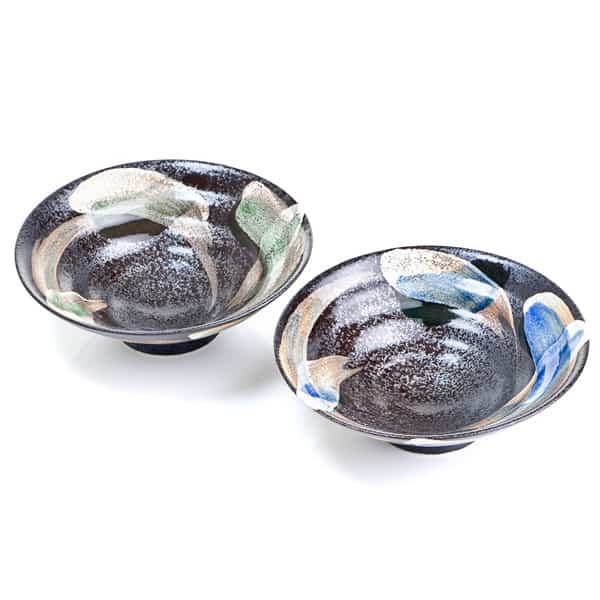The Story behind Japanese Bowls with Gold Cracks
You may have seen
Japanese bowls repaired with gold (if not, take a look at
these). I think you’ll agree that they look rather beautiful. Given the nature of their production, each one is unique and consequently has its own special character. But have you ever wondered where the idea first came from?
Japanese Bowl Repairs in Popular Folklore
This age-old tradition, known as
kintsugi (‘gold joinery’ or to ‘patch with gold’), is said to have come about during the late 15
th Century. According to
Blake Gopnik, the shogun Ashikaga Yoshimasa sent a broken tea bowl back to China to be fixed. To his horror, it came back held together with ugly metal staples. Japanese craftsmen were faced with a new challenge: to find a way of making broken crockery look as good as new – or even better.
Their solution became so popular that many Japanese collectors were accused of deliberately breaking prized ceramics so that they could have them repaired in gold. After all, why wouldn’t you want to make a priceless work of art even more valuable?
The imperfection of these bowls has since come to be cherished, and their repairs seen as a creative addition. Many people see
kintsugi as a symbol of rebirth supporting an ancient philosophy that nothing is ever truly broken beyond disrepair. Rather than hiding the damage of a broken bowl, plate or mug, kintsugi emphasises the breakages, creating a new and improved golden pattern into the tableware so it becomes even more valuable than before.
 Kintsugi in the Modern Day
Kintsugi in the Modern Day
Over time, the
kintsugi method spread to China, Vietnam and Korea. Since then it is said to have inspired craftsmen all over the world in the use of decorative finishes such as Crackleglaze and gold lustre.
Dick Lehman, a contemporary potter, came across
kintsugi while on his travels. According to him,
Japanese bowls and other ceramics are now repaired in a wide range of materials, including “
lacquer, epoxy, gold dust, mica dust, copper dust, silver dust, gold leaf … just to name a few”.
Naturally, the choice of material depends on the context. For example, museum pieces would most likely be repaired using genuine gold dust mixed with resin, while cheap repairs on everyday objects might be carried out using gold coloured epoxy paste.
However, purists believe that
kintsugi should only be used to repair extremely valuable, antique ceramic works. This has become a point of contention as many potters worldwide use this method to repair newly made goods that come out flawed or cracked (using cheaper alternatives to real gold, of course).

If you would like
kintsugi-inspired crockery for your home, check out the Japanese Shop’s range of
Crackleglaze tableware. Our
Gold Flash 2 bowl set also offers a contemporary take on the tradition, for truly stunning and eye-catching results.
You can also read
this informative article to find out more about
Japanese bowls repaired with gold.
 Kintsugi in the Modern Day
Over time, the kintsugi method spread to China, Vietnam and Korea. Since then it is said to have inspired craftsmen all over the world in the use of decorative finishes such as Crackleglaze and gold lustre.
Dick Lehman, a contemporary potter, came across kintsugi while on his travels. According to him, Japanese bowls and other ceramics are now repaired in a wide range of materials, including “lacquer, epoxy, gold dust, mica dust, copper dust, silver dust, gold leaf … just to name a few”.
Naturally, the choice of material depends on the context. For example, museum pieces would most likely be repaired using genuine gold dust mixed with resin, while cheap repairs on everyday objects might be carried out using gold coloured epoxy paste.
However, purists believe that kintsugi should only be used to repair extremely valuable, antique ceramic works. This has become a point of contention as many potters worldwide use this method to repair newly made goods that come out flawed or cracked (using cheaper alternatives to real gold, of course).
Kintsugi in the Modern Day
Over time, the kintsugi method spread to China, Vietnam and Korea. Since then it is said to have inspired craftsmen all over the world in the use of decorative finishes such as Crackleglaze and gold lustre.
Dick Lehman, a contemporary potter, came across kintsugi while on his travels. According to him, Japanese bowls and other ceramics are now repaired in a wide range of materials, including “lacquer, epoxy, gold dust, mica dust, copper dust, silver dust, gold leaf … just to name a few”.
Naturally, the choice of material depends on the context. For example, museum pieces would most likely be repaired using genuine gold dust mixed with resin, while cheap repairs on everyday objects might be carried out using gold coloured epoxy paste.
However, purists believe that kintsugi should only be used to repair extremely valuable, antique ceramic works. This has become a point of contention as many potters worldwide use this method to repair newly made goods that come out flawed or cracked (using cheaper alternatives to real gold, of course).
 If you would like kintsugi-inspired crockery for your home, check out the Japanese Shop’s range of Crackleglaze tableware. Our Gold Flash 2 bowl set also offers a contemporary take on the tradition, for truly stunning and eye-catching results.
You can also read this informative article to find out more about Japanese bowls repaired with gold.
If you would like kintsugi-inspired crockery for your home, check out the Japanese Shop’s range of Crackleglaze tableware. Our Gold Flash 2 bowl set also offers a contemporary take on the tradition, for truly stunning and eye-catching results.
You can also read this informative article to find out more about Japanese bowls repaired with gold.

